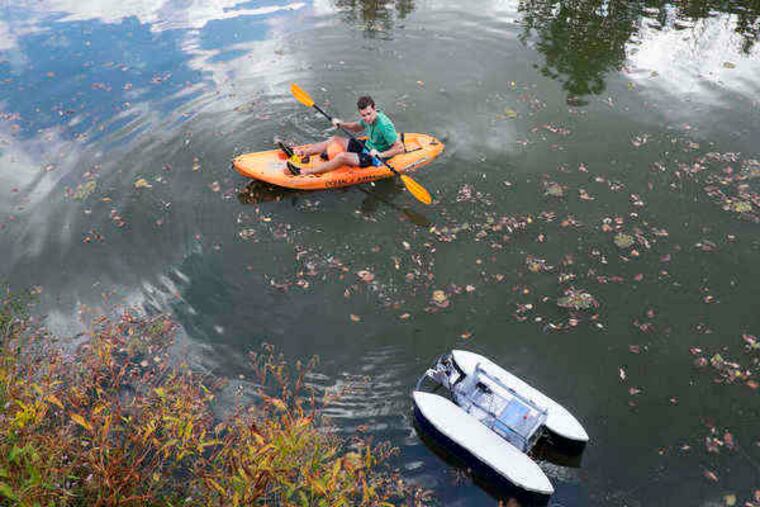A Villanova team takes robotics on the water
More than seven months after the disappearance of Malaysia Airlines Flight 370, the search for the plane is expected to resume in the Indian Ocean this month with crews trolling 23,000 square miles.

More than seven months after the disappearance of Malaysia Airlines Flight 370, the search for the plane is expected to resume in the Indian Ocean this month with crews trolling 23,000 square miles.
Might the kernel of a better approach be found in a pond in Phoenixville?
That is where Villanova University students are tinkering with a robotic boat, a two-pontoon craft equipped with a camera, a laser, and other electronics that let the boat locate obstacles and navigate on its own.
The four-foot vessel is a prototype for a 16-foot version that the students and two faculty members will enter this month in a competition in Singapore, along with partners from Florida Atlantic University.
The organizers of the Maritime RobotX Challenge do not mention searching for airline debris in the competition materials. But they say autonomous watercraft could be used for all sorts of tasks where humans need help in such a vast environment: tracking oil spills, monitoring fish populations, even watching out for pirates in shipping lanes.
A robotic boat also could serve as a mobile platform for smaller flying robots or submarines, "almost like mini-aircraft carriers," said Daryl Davidson, executive director of the Association for Unmanned Vehicle Systems International (AUVSI) Foundation, a nonprofit outreach group with ties to industry, government, and academia.
"We're just taking people out of the loop in many respects and doing things more effectively, more cheaply, and more safely," Davidson said.
The competition, to take place from Oct. 20 to 26 in Singapore's Marina Bay, requires the 15 entrants to complete five tasks, including detecting and navigating around buoys, docking the boat, and locating an underwater device that emits a ping. In addition to the foundation, organizers include the U.S. Office of Naval Research and Singapore's ministry of defense.
The boats must run on their own, with no remote control, and they get no electronic map of their surroundings in advance. All information about location and obstacles has to be captured by the onboard sensors, said team leader Anderson Lebbad, who is working on a master's degree in mechanical engineering.
"It figures it out as it goes," Lebbad said. "Part of the puzzle."
The faculty adviser from Villanova is C. "Nat" Nataraj, a professor of mechanical engineering who has been working on the challenge of robotic boats for more than a decade.
Similar competitions have been held for driverless cars, using many of the same kinds of cameras and sensors that are being used on the boats.
But unlike pavement, water moves. The interplay of forces between the boat and its uncontained, sloshing environment makes for some difficult math.
"It is what we call a moving boundary problem," Nataraj said.
The water in the bay in Singapore is fairly calm. Still, the elements will be an issue. Heavy showers are common there this time of year, which could throw the boats' onboard cameras for a loop. Boats also cannot turn and maneuver as easily as cars.
In one task, the boats must guide themselves between a series of buoys, keeping green ones to the right and red ones to their left. So the cameras must detect the colors, and the software must deliver power to the boats' battery-powered propellers accordingly.
On a sunny day at the pond earlier this month, the four-foot prototype navigated between a series of red and green buoys just fine. J. "Wes" Anderson, who is working on his master's degree in mechanical engineering, floated nearby in a kayak in case anything went amiss.
The Villanova portion of the team includes eight students, including undergraduates. Six will make the trek to Singapore, along with Nataraj and Garrett M. Clayton, a Villanova associate professor of mechanical engineering who is an expert on computer vision systems.
The process has not been without setbacks. At one point, the prototype was overcorrecting, turning too far in the opposite direction to compensate for going off-course.
Among other challenges, the software must "fuse" multiple sources of data. For example, an image of a given object captured by the camera must be married to a measurement of its distance from the boat, which is captured by the laser.
The software contains well over a half-million lines of computer code, and it has been through more than 100 updates, Nataraj said. Students tweak the code on the prototype, then periodically travel to Florida Atlantic's Dania Beach campus to try it on the big boat.
The team and two others from the United States were selected from a pool of a dozen U.S. applicants. The remaining 12 teams in the competition were chosen from Japan, South Korea, Singapore, and Australia. All will fight over $100,000 in prizes.
The cost of the Villanova-Florida Atlantic entry was $350,000, most of which was raised from sponsors. The practice pond is owned by VideoRay, a robotics company in Pottstown.
The fund-raising and organizational aspects of the project meant the students had to sharpen their entrepreneurial skills.
And while they were at it, why not throw in a dash of the humanities? The team's website contains a quotation from "The Owl and the Pussycat," the Edward Lear poem - appropriate, given that Florida Atlantic's mascot is the owl and Villanova's the wildcat.
It makes for a blunt-sounding acronym, however. The team name is WORX, for Wildcats Owls RobotX.
Said Nataraj:
"We may be better engineers than we are linguists."